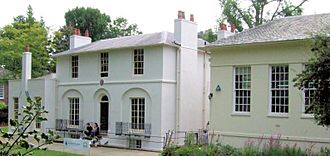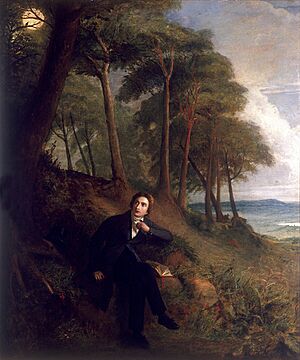Keats House facts for kids
Quick facts for kids Keats House |
|
|---|---|

Keats House, Keats Grove (formerly John Street), pictured prior to reopening in 2009 after restoration. Adjoining on the right is the Heath Branch Public Library
|
|
| Former names | Wentworth Place Wentworth Cottage Lawn Cottage Laurel Cottage Lawn Bank |
| General information | |
| Architectural style | Regency |
| Location | 10 Keats Grove, Hampstead, London, NW3 2RR |
| Country | United Kingdom |
| Construction started | c. 1814–15 |
| Completed | c. 1815–16 |
| Cost | Restoration: c. £500,000 (£424,000 from Heritage Lottery Fund) |
| Designations | Grade I listed |
Keats House is a special museum in London, England. It used to be the home of a famous Romantic poet named John Keats. The house is located in a part of north London called Hampstead.
This building was originally two houses joined together, known as "Wentworth Place." John Keats lived in one part of the house with his friend Charles Armitage Brown from December 1818 to May 1820. Later, he stayed in the other part with the Brawne family. These years were very important for Keats's writing. His friend Charles Brown said that Keats wrote his famous poem, "Ode to a Nightingale," under a plum tree in the garden.
While living here, Keats fell in love with Fanny Brawne, who lived next door. They even got engaged! Sadly, Keats became very sick with tuberculosis. Doctors told him to move to a warmer place. He left London in 1820 and passed away in Italy the next year. He was never married. Today, Keats House is a very important historical building.
Contents
The Story of Keats House
Keats House was built between 1814 and 1816. It was one of the first houses in this part of Hampstead.
In October 1816, Charles Wentworth Dilke and his friend Charles Armitage Brown moved into the house. John Keats started visiting in 1817. He was introduced to Dilke by another friend, John Hamilton Reynolds. In December 1818, after Keats's brother Tom died, Charles Brown invited Keats to live with him. Keats paid a small amount each month to share the house.
In April 1819, Dilke and his family moved out. They rented their part of the house to Mrs. Brawne and her family. The Brawnes had briefly stayed in Brown's half of the house when Keats and Brown were traveling.
After John Keats died in 1821, his sister Fanny became friends with Fanny Brawne. Fanny Keats and her husband lived in what was Brown's half of the house from 1828 to 1831. Mrs. Brawne passed away in December 1829. By March 1830, the Brawne family had also moved out.
Many interesting people lived in the house during the 1800s. These included a painter named Henry Courtney Selous and a retired actress, Eliza Chester. Eliza Chester even changed the house into one big home. A special blue sign was put on the house in 1896 to remember Keats.
The house was lived in almost all the time until the 1900s. Then, there was a plan to tear it down. But people raised money to save it! Keats House opened to the public as a museum on May 9, 1925.
In 2009, the museum hosted a play called Keats in Hampstead. It was about Keats's life, his poems, and his love for Fanny Brawne.
Exploring the Museum

Next to Keats House, there is another building. This building was once a kitchen garden and a coach house. On July 16, 1931, it opened as the 'Keats Museum and Branch Library'. It had a public library and a room to show things from the Keats House collection. Some of these items were given by the family of Charles Armitage Brown.
The public library in this building closed in March 2012. However, the building reopened in April 2012 as "Ten Keats Grove." Now, volunteers help run a library in part of the building.
Inside Keats House, you can see many interesting items. These include the engagement ring Keats gave to Fanny Brawne. You can also see a copy of Keats's death mask. The museum often has poetry events and other literary activities. It also offers educational programs for visitors.
In December 2006, the house received money for a big restoration project. This project was partly paid for by a grant of £424,000. Keats House closed for the work on November 1, 2007. It reopened to visitors on July 24, 2009.
To help support the house, the Keats Foundation was started in November 2010. This group helps with the care and upkeep of the museum.
The Mulberry Tree in the Garden
The garden at Keats House has a very old Mulberry tree. It is a Common or Black Mulberry tree. People believe it might be from the 1600s! Mulberry trees are not native to England. They have been grown there since at least the early 1500s.
There were other fruit trees in the garden of Keats House. So, the mulberry tree might have been part of an old fruit orchard. If the tree is as old as people think, then John Keats would have definitely seen it. He did not write about this specific tree. However, he did mention a white mulberry tree in a letter to his friend John Hamilton Reynolds in July 1818.
How to Visit Keats House
Keats House is located on the south side of Keats Grove. It is between St John's Church and South End Road in Hampstead, London. The postcode is NW3 2RR.
You can get there by train or tube. The closest train station is Hampstead Heath railway station. The closest tube stations are Belsize Park and Hampstead tube station. Both are on the Northern line. If you are coming from central London, you can take red bus route 24. It stops at South End Green, which is very close to the house.
See also
- Keats-Shelley Memorial House, Rome, Italy


